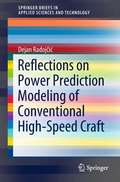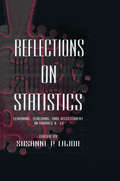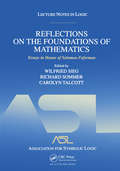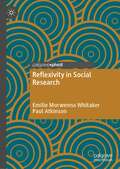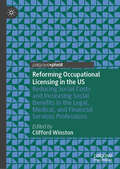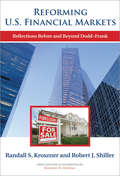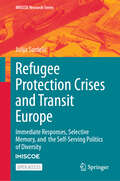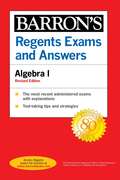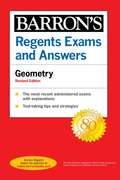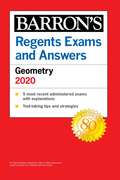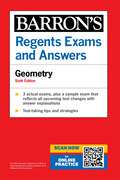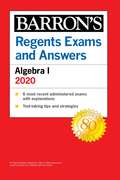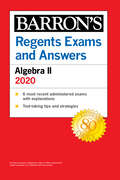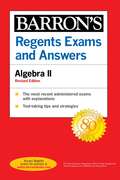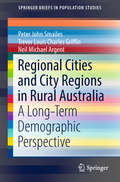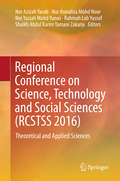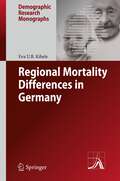- Table View
- List View
Reflections on Power Prediction Modeling of Conventional High-Speed Craft (SpringerBriefs in Applied Sciences and Technology)
by Dejan RadojčićThis SpringerBrief focuses on modeling and power evaluation of high-speed craft. The various power prediction methods, a principal design objective for high-speed craft of displacement, semi-displacement, and planing type, are addressed. At the core of the power prediction methods are mathematical models for resistance and propulsion efficiency. The models are based on the experimental data of various high-speed hull and propeller series. The regression analysis and artificial neural network (ANN) methods are used as an extraction tool for this kind of mathematical models. A variety of mathematical models of this type are discussed in the book.Once these mathematical models have been developed and validated, they can be readily programmed into software tools, thereby enabling the parametric analyses required for the optimization of a high-speed craft design. This book provides the foundational reference for these software tools, and their use in the design of high-speed craft. High-speed craft are very different from conventional ships. Current professional literature leaves a gap in the documentation of best design practices for high-speed craft. This book is aimed at naval architects who design and develop various types of high-speed vessels.
Reflections on Statistics: Learning, Teaching, and Assessment in Grades K-12 (Studies in Mathematical Thinking and Learning Series)
by Susanne P. LajoieAn issue in the current push for reform in mathematics education is the call to address statistics at the precollege level. This volume represents the emerging findings of an interdisciplinary collaboration among a group of mathematics educators, cognitive scientists, teachers, and statisticians to construct an understanding of how to introduce statistics education and assessment for students in elementary and secondary schools. A premise shared by the contributors to this volume is that when students are introduced to statistics at the K-12 level and provided with opportunities to do statistics that are related to actual life situations, they will be better prepared for decision making in the real world. The interdisciplinary nature of the group of researchers stimulated a lively interchange of ideas for enhancing the learning, teaching, and assessment of statistical understanding, which is reflected in this volume. Mathematics educators contribute their insights into how teachers teach mathematical ideas and heighten our awareness of the ecological needs of the current mathematics classroom. Cognitive scientists share their understanding of developmental differences in learning and present theoretical perspectives that contribute to the design of effective learning environments. Classroom teachers share their ideas about classroom activities and assessment of student learning, as well as their concerns for in-service training and workshops to help teachers acquire skills in this new content area. Statisticians offer their understanding of what is feasible to teach in the early grades, and what their view is of statistical literacy. The book is organized around four interdependent themes: content, teaching, learning, and assessment. By focusing their respective chapters on particular themes, the authors intend to cultivate a better understanding of how each relates to improvements in statistics education. This is the first book to: * address statistics learning in grades K-12, * address issues of statistical curriculum content in grades K-12, * address issues of assessment of statistics learning in grades K-12, * bring issues of technology instruction and assessment in statistics education in grades K-12, and * look at teacher education for statistics instruction in grades K-12. This is a must-read book for both practitioners and researchers involved in K-12 mathematics education.
Reflections on the Foundations of Mathematics: Lecture Notes in Logic 15
by Carolyn Talcott Wilfried Sieg Richard SommerSolomon Feferman has shaped the field of foundational research for nearly half a century. These papers, most of which were presented at the symposium honoring him at his 70th birthday, reflect his broad interests as well as his approach to foundational research, which places the solution of mathematical and philosophical problems at the top of his
Reflections on the Foundations of Mathematics: Univalent Foundations, Set Theory and General Thoughts (Synthese Library #407)
by Stefania Centrone Deborah Kant Deniz SarikayaThis edited work presents contemporary mathematical practice in the foundational mathematical theories, in particular set theory and the univalent foundations. It shares the work of significant scholars across the disciplines of mathematics, philosophy and computer science. Readers will discover systematic thought on criteria for a suitable foundation in mathematics and philosophical reflections around the mathematical perspectives.The volume is divided into three sections, the first two of which focus on the two most prominent candidate theories for a foundation of mathematics. Readers may trace current research in set theory, which has widely been assumed to serve as a framework for foundational issues, as well as new material elaborating on the univalent foundations, considering an approach based on homotopy type theory (HoTT). The third section then builds on this and is centred on philosophical questions connected to the foundations of mathematics. Here, the authors contribute to discussions on foundational criteria with more general thoughts on the foundations of mathematics which are not connected to particular theories.This book shares the work of some of the most important scholars in the fields of set theory (S. Friedman), non-classical logic (G. Priest) and the philosophy of mathematics (P. Maddy). The reader will become aware of the advantages of each theory and objections to it as a foundation, following the latest and best work across the disciplines and it is therefore a valuable read for anyone working on the foundations of mathematics or in the philosophy of mathematics.
Reflective Boundary Conditions in SPH Fluid Dynamics Simulation: Two and Three-dimensional Validation and Applications (Synthesis Lectures on Mechanical Engineering)
by Carlos Alberto Fraga FilhoThis book presents results from applying Reflective Boundary Conditions (RBC) in particle simulations coupled with the Smoothed Particle Hydrodynamics (SPH) Method in two- and three-dimensional domains. The contribution of this work lies in the presentation of the state of the art regarding the application of physical and realistic boundary conditions in the continuum domain, which is an advance in the artificial computational boundary treatment carried out in most SPH simulations. By reading this work, researchers from different fields dealing with Computational Fluid Dynamics (CFD) will be aware of the most recent results of applying the SPH method coupled with RBC, confirming its scientific validity and encouraging its implementation in other problems. This multidisciplinary work is aimed at undergraduate and postgraduate students, researchers, software developers, and other engineering, physics, chemistry, mathematics, and related sciences professionals.
Reflexion and Control: Mathematical Models (Communications in Cybernetics, Systems Science and Engineering)
by Dmitry A. Novikov Alexander G. ChkhartishviliThis book is dedicated to modern approaches to mathematical modeling of reflexive processes in control. The authors consider reflexive games that describe the gametheoretical interaction of agents making decisions based on a hierarchy of beliefs regarding (1) essential parameters (informational reflexion), (2) decision principles used by opponents
Reflexionsfähigkeit von Lehrkräften über metakognitive Schülerprozesse beim mathematischen Modellieren (Perspektiven der Mathematikdidaktik)
by Lisa WendtIn dem vorliegenden Buch wird die Reflexionsfähigkeit von Lehrkräften über metakognitive Schülerprozesse beim mathematischen Modellieren untersucht. Berücksichtigt wird dabei, in welchem Umfang Lehrkräfte die metakognitiven Schülerprozesse hinblickend auf die Förderung metakognitiver Aktivitäten analysieren und inwieweit sie dabei eigene Handlungsoptionen und bereits implementierte Interventionen reflektieren. Durch die Analysen wird empirisch basiert eine Typologie an Reflexionstypen von Lehrkräften über metakognitive Schülerprozesse generiert, hierarchisiert mit Blick auf die Förderung metakognitiver Aktivitäten in einem Niveaustufensystem.
Reflexivity in Social Research
by Paul Atkinson Emilie Morwenna WhitakerThis book provides students and researchers with clear guidance through this tricky, but fundamental aspect of qualitative, ethnographic research. The chapters provide a concise overview that clarifies, illustrates and develops a highly popular methodological principle. To some extent, the book is critical of some contemporary approaches, particularly those that portray reflexivity as an optional, virtuous extra. Drawing on a broad range of anthropological, sociological and other sources, it illuminates through example as well as by precept.
Reforming Occupational Licensing in the US: Reducing Social Costs and Increasing Social Benefits in the Legal, Medical, and Financial Services Professions
by Clifford WinstonNearly one-third of US workers must obtain a license from a government agency to perform their jobs legally. This impacts employees across all areas, including lawyers, doctors, and accountants, as well as florists, hairdressers, physical therapists, and plumbers. The justification for occupational licensing is that potential consumers allegedly lack the information and knowledge to judge the competence of a service provider. This necessitates a licensing system built to ensure that customers are served by people who have received adequate training and certification in their profession. While there are recognizable benefits of occupational licensing, the training and certification requirements create barriers to entry for employees or those entering the profession. These barriers can limit competition, raise service costs, and restrict consumer access to essential services. Recent empirical work suggests that consumers have incurred these costs without being adequately protected from incompetent or unscrupulous service providers. This book addresses this situation head on. In light of occupational licensing's shortcomings, the authors of this book propose and analyze constructive reforms, assessing their effects on key professions such as law, medicine, and finance. Chapters identify the significant costs of current policies and they recommend practical reforms that rely more on market forces. The resulting book provides new ways to reduce licensing costs without compromising service quality.
Reforming U.S. Financial Markets: Reflections Before and Beyond Dodd-Frank (Alvin Hansen Symposium on Public Policy at Harvard University)
by Robert J. Shiller Randall S. KrosznerTwo top economists outline distinctive approaches to post-crisis financial reform.Over the last few years, the financial sector has experienced its worst crisis since the 1930s. The collapse of major firms, the decline in asset values, the interruption of credit flows, the loss of confidence in firms and credit market instruments, the intervention by governments and central banks: all were extraordinary in scale and scope. In this book, leading economists Randall Kroszner and Robert Shiller discuss what the United States should do to prevent another such financial meltdown. Their discussion goes beyond the nuts and bolts of legislative and regulatory fixes to consider fundamental changes in our financial arrangements. Kroszner and Shiller offer two distinctive approaches to financial reform, with Kroszner providing a systematic analysis of regulatory gaps and Shiller addressing the broader concerns of democratizing and humanizing finance. After brief discussions by four commentators (Benjamin M. Friedman, George G. Kaufman, Robert C. Pozen, and Hal S. Scott), Kroszner and Shiller each offer a response to the other's proposals, creating a fruitful dialogue between two major figures in the field.
Refresher: Computation Algebra Geometry
by Steck-VaughnReading and Writing Numbers This Refresher book is the most comprehensive of its kind, covering basic computation through algebra and geometry skills.
Refugee Protection Crises and Transit Europe: Immediate Responses, Selective Memory, and the Self-Serving Politics of Diversity (IMISCOE Research Series)
by Julija SardelićThis open-access book presents a socio-legal analysis of immediate responses to large-scale refugee displacement in Europe after the 1951 Refugee Convention came into force, focusing on the countries to which refugees initially fled or through which they passed (namely Austria and, initially, Yugoslavia, followed by several of the former Yugoslav countries). First, it investigates the immediate responses to refugee movements following the suppression of the 1956 Hungarian Revolution by Soviet troops. Second, it examines the responses to individuals seeking asylum after being displaced during the post-Yugoslav wars of the 1990s. Third, it analyses the responses of the same countries to refugees fleeing Global South countries (predominantly Syria, Iraq, and Afghanistan) in 2015 and 2016. Finally, it explores how these countries responded to the mass displacement of refugees from Ukraine. The book argues that these countries have positioned themselves as &“transit&” or temporary protection countries in order to avoid assuming long-term responsibility for a larger number of refugees. As a consequence, they granted various forms of temporary legal status to refugees that differed from the refugee status defined in the 1951 Refugee Convention. These legal statuses were hierarchical (in terms of the rights attached to them) and racialized, with the fewest rights granted to refugees from the Global South and other negatively racialized groups. The book traces the usage of self-serving politics of diversity and selective memory to legitimise why refugees could not be protected long-term in these countries, and also why there were such differences in treatment of refugees.
Regents Algebra I Power Pack Revised Edition (Barron's Regents NY)
by Gary M. RubinsteinBarron&’s two-book Regents Algebra I Power Pack provides comprehensive review, actual administered exams, and practice questions to help students prepare for the Algebra I Regents exam. All Regents test dates for 2020 have been canceled. Currently the State Education Department of New York has released tentative test dates for the 2021 Regents. The dates are set for January 26-29, 2021, June 15-25, 2021, and August 12-13th. This edition includes:One actual Regents exam onlineRegents Exams and Answers: Algebra I Six actual, administered Regents exams so students can get familiar with the testReview questions grouped by topic, to help refresh skills learned in classThorough explanations for all answersScore analysis charts to help identify strengths and weaknessesStudy tips and test-taking strategiesLet's Review Regents: Algebra I Comprehensive review of all topics on the testExtra exercise problems with answersTwo actual, administered Regents Algebra I exams with answer keysThe Power Pack includes two volumes for a savings of $4.99.
Regents Algebra II Power Pack Revised Edition (Barron's Regents NY)
by Gary M. RubinsteinBarron&’s two-book Regents Algebra II Power Pack provides comprehensive review, actual administered exams, and practice questions to help students prepare for the Algebra II Regents exam. All Regents test dates for 2020 have been canceled. Currently the State Education Department of New York has released tentative test dates for the 2021 Regents. The dates are set for January 26-29, 2021, June 15-25, 2021, and August 12-13th. This edition includes:One actual Regents exam onlineRegents Exams and Answers: Algebra IISix actual, administered Regents exams so students have the practice they need to prepare for the testReview questions grouped by topic, to help refresh skills learned in classThorough explanations for all answersScore analysis charts to help identify strengths and weaknessesStudy tips and test-taking strategiesLet&’s Review Regents: Algebra IIExtensive review of all topics on the test, including Polynomial Functions, Exponents and Equations, Transformation of Functions, Trigonometric Functions and Graphs, and Using Sine and CosineExtra exercise problems with answersTwo actual, administered Regents exams so students can get familiar with the testThe Power Pack includes two volumes for a savings of $4.99.
Regents Exams and Answers Algebra I Revised Edition (Barron's Regents NY)
by Gary M. RubinsteinBarron&’s Regents Exams and Answers: Algebra I 2020 provides essential review for students taking the Algebra I Regents, including actual exams administered for the course, thorough answer explanations, and comprehensive review of all topics. All Regents test dates for 2020 have been canceled. Currently the State Education Department of New York has released tentative test dates for the 2021 Regents. The dates are set for January 26-29, 2021, June 15-25, 2021, and August 12-13th. This edition features:Six actual, administered Regents exams so students can get familiar with the testComprehensive review questions grouped by topic, to help refresh skills learned in classThorough explanations for all answersScore analysis charts to help identify strengths and weaknessesStudy tips and test-taking strategiesAll pertinent math topics are covered, including sets, algebraic language, linear equations and formulas, ratios, rates, and proportions, polynomials and factoring, radicals and right triangles, area and volume, and quadratic and exponential functions.Looking for additional practice and review? Check out Barron&’s Regents Algebra I Power Pack 2020two-volume set, which includes Let&’s Review Regents: Algebra I 2020 in addition to Regents Exams and Answers: Algebra I 2020.
Regents Exams and Answers Geometry Revised Edition (Barron's Regents NY)
by Andre Castagna Ph.D.Barron&’s Regents Exams and Answers: Geometry 2020 provides essential review for students taking the Geometry Regents, including actual exams administered for the course, thorough answer explanations, and comprehensive review of all topics.All Regents test dates for 2020 have been canceled. Currently the State Education Department of New York has released tentative test dates for the 2021 Regents. The dates are set for January 26-29, 2021, June 15-25, 2021, and August 12-13th. This edition features:Six actual, administered Regents exams so students can get familiar with the testComprehensive review questions grouped by topic, to help refresh skills learned in classThorough explanations for all answersScore analysis charts to help identify strengths and weaknessesStudy tips and test-taking strategiesAll pertinent geometry topics are covered, such as basic angle and segment relationships (parallel lines, polygons, triangle relationships), constructions, transformations, triangle congruence and writing proofs, similarity and right triangle geometry, parallelograms, circles and arcs, coordinate geometry, and volume (modeling 3-D shapes in practical applications).Looking for additional practice and review? Check out Barron&’s Regents Geometry Power Pack 2020 two-volume set, which includes Let&’s Review Regents: Geometry 2020 in addition to the Regents Exams and Answers: Geometry book.
Regents Exams and Answers: Geometry (Barron's Regents)
by Andre CastagnaBarron’s Regents Exams and Answers: Geometry 2020 provides essential review for students taking the Geometry Regents, including actual exams administered for the course, thorough answer explanations, and comprehensive review of all topics.This edition features: Five actual, administered Regents exams so students can get familiar with the test, Comprehensive review questions grouped by topic, to help refresh skills learned in class, Thorough explanations for all answers, Score analysis charts to help identify strengths and weaknesses, Study tips and test-taking strategiesAll pertinent geometry topics are covered, such as basic angle and segment relationships (parallel lines, polygons, triangle relationships), constructions, transformations, triangle congruence and writing proofs, similarity and right triangle geometry, parallelograms, circles and arcs, coordinate geometry, and volume (modeling 3-D shapes in practical applications). Looking for additional practice and review? Check out Barron’s Regents Geometry Power Pack 2020 two-volume set, which includes Let’s Review Regents: Geometry 2020 in addition to the Regents Exams and Answers: Geometry book.
Regents Exams and Answers: Geometry, Sixth Edition (Barron's New York Regents)
by Barron's Educational Series Andre, Ph.D. Castagna Ph.D.Barron&’s Regents Exams and Answers: Geometry provides essential review for students taking the Geometry Regents, including actual exams administered for the course, thorough answer explanations, and comprehensive review of all topics.This edition features: Three actual, administered Regents exams so students can get familiar with the test, plus one new sample test for the most recent exam changes for June 2025. Fully revised and up-to-date review and practice grouped by topic, to help refresh skills learned in class Thorough explanations for all answers Score analysis charts to help identify strengths and weaknesses Study tips and test-taking strategies All geometry topics are covered, such as basic angle and segment relationships (parallel lines, polygons, triangle relationships), constructions, transformations, triangle congruence and writing proofs, similarity and right triangle geometry, parallelograms, circles and arcs, coordinate geometry, and volume (modeling 3-D shapes in practical applications). Publisher's Note: Products purchased from 3rd party sellers are not guaranteed by the publisher for quality, authenticity, or access to any online entities included with the product.
Regents Exams and Answers: Let's Review Algebra I + Regents Exams And Answers: Algebra I (Barron's Regents NY)
by Gary M. RubinsteinThis edition will prepare students for the Algebra I Regents exam and includes the most recent tests through August 2017. It features: * Six actual Regents exams administered for the updated Algebra I course * Comprehensive review questions, grouped by topic * All answers fully explained * Study tips, test-taking strategies, score analysis charts, and more valuable features Students will find a review of all pertinent math topics, including sets, algebraic language, linear equations and formulas, ratios, rates, and proportions, polynomials and factoring, radicals and right triangles, area and volume, quadratic and exponential functions, and much more. It's an essential, must-have guide to preparing for the Algebra I Regents.
Regents Exams and Answers: Let's Review Algebra II + Barron's Regents Exams And Answers: Algebra Ii (Barron's Regents NY)
by Gary Michael RubinsteinBarron's Regents Exams and Answers: Algebra II 2020 provides essential review for students taking the Algebra II (Common Core) exam, including actual exams administered for the course, thorough answer explanations, and comprehensive review of all topics. This edition features: * Six actual, administered Regents exams so students have the practice they need to prepare for the test * Comprehensive review questions grouped by topic, to help refresh skills learned in class * Thorough explanations for all answers * Score analysis charts to help identify strengths and weaknesses * Study tips and test-taking strategies All algebra II topics are covered, including Polynomial Equations, Rational Equations, Exponential and Logarithmic Equations, Systems of Equations with Three Variables, Functions, Sequences, and Probability. Looking for additional practice and review? Check out Barron’s Regents Algebra II Power Pack 2020 two-volume set, which includes Let’s Review Regents: Algebra II 2020 in addition to the Regents Exams and Answers: Algebra II 2020 book.
Regents Exams and Answers: Let's Review Algebra Ii + Regents Exams And Answers: Algebra Ii (Barron's Regents NY)
by Gary Michael RubinsteinBarron's Regents Exams and Answers: Algebra II 2020 provides essential review for students taking the Algebra II (Common Core) exam, including actual exams administered for the course, thorough answer explanations, and comprehensive review of all topics. All Regents test dates for 2020 have been canceled. Currently the State Education Department of New York has released tentative test dates for the 2021 Regents. The dates are set for January 26-29, 2021, June 15-25, 2021, and August 12-13th. This edition features:Six actual, administered Regents exams so students have the practice they need to prepare for the testComprehensive review questions grouped by topic, to help refresh skills learned in classThorough explanations for all answersScore analysis charts to help identify strengths and weaknessesStudy tips and test-taking strategiesAll algebra II topics are covered, including Polynomial Equations, Rational Equations, Exponential and Logarithmic Equations, Systems of Equations with Three Variables, Functions, Sequences, and Probability.Looking for additional practice and review? Check out Barron&’s Regents Algebra II Power Pack 2020 two-volume set, which includes Let&’s Review Regents: Algebra II 2020 in addition to the Regents Exams and Answers: Algebra II 2020 book.
Regents Geometry Power Pack Revised Edition (Barron's Regents NY)
by Andre Castagna Ph.D.Barron&’s two-book Regents Geometry Power Pack provides comprehensive review, actual administered exams, and practice questions to help students prepare for the Geometry Regents exam. All Regents test dates for 2020 have been canceled. Currently the State Education Department of New York has released tentative test dates for the 2021 Regents. The dates are set for January 26-29, 2021, June 15-25, 2021, and August 12-13th. This edition includes:Two actual Regents exams onlineRegents Exams and Answers: Geometry Five actual, administered Regents exams so students have the practice they need to prepare for the testReview questions grouped by topic, to help refresh skills learned in classThorough explanations for all answersScore analysis charts to help identify strengths and weaknessesStudy tips and test-taking strategiesLet's Review Regents: Geometry Comprehensive review of all topics on the testExtra practice questions with answersTwo actual, administered Regents Geometry exams with answer keysTopics covered include basic geometric relationships (parallel lines, polygons, and triangle relationships), an introduction to geometric proof transformations, similarity and right triangle trigonometry, parallelograms, and volume (modeling 3-D shapes in practice applications).The Power Pack includes two volumes for a savings of $4.99.
Regional Cities and City Regions in Rural Australia: A Long-Term Demographic Perspective (SpringerBriefs in Population Studies)
by Peter John Smailes Trevor Louis Griffin Neil Michael ArgentThe book examines the extent to which the sustained population growth of Australia’s heartland regional centres has come at the expense of demographic decline in their own hinterlands, and, ultimately, of their entire regions. It presents a longitudinal study, over the period 1947-2011, of the extensive functional regions centred on six rapidly growing non-metropolitan cities in south-eastern Australia, emphasising rapid change since 1981. The selected cities are dominantly service centres in either inland or remote coastal agricultural settings. The book shows how intensified age-specific migration and structural ageing arising from macro-economic reforms in the 1980s fundamentally changed the economic and demographic landscapes of the case study regions. It traces the demographic consequences of the change from a relative balance between central city, minor urban centres and dispersed rural population within each functional region in 1947, to one of extreme central city dominance by 2011, and examines the long-term implications of these changes for regional policy. The book constitutes the first in-depth longitudinal study over the entire post-WWII period of a varied group of Australian regional cities and their hinterlands, defined in terms of functional regions. It employs a novel set of indices which combine numerical and visual expression to measure the structural ageing process.
Regional Conference on Science, Technology and Social Sciences: Theoretical And Applied Sciences (RCSTSS #2016)
by Nor Azizah Yacob Nur Asmaliza Mohd Noor Nor Yuziah Mohd Yunus Rahmah Lob Yussof Shaikh Abdul Karim Yamani ZakariaThis book gathers selected theoretical and applied science papers presented at the 2016 Regional Conference of Sciences, Technology and Social Sciences (RCSTSS 2016), organized biannually by the Universiti Teknologi MARA Pahang, Malaysia. Addressing a broad range of topics, including architecture, computer science, engineering, environmental and management, furniture, forestry, health and medicine, material science, mathematics, plantation and agrotechnology, sports science and statistics, the book serves as an essential platform for disseminating research findings, and inspires positive innovations in the region’s development.The carefully reviewed papers in this volume present work by researchers of local, regional and global prominence. Taken together, they offer a valuable reference guide and point of departure for all academics and students who want to pursue further research in their respective fields.
Regional Mortality Differences in Germany
by Eva U.B. KibeleRegional mortality differences are one dimension of health inequalities, but its trends and determinants in Germany are widely unknown. This book examines and illustrates patterns of regional mortality in Germany--with focus on small-area differentials--and their changes over time. It identifies explanatory factors at individual and regional level. Mortality differences between eastern and western Germany exist, but small-area mortality differentials are often greater. Though the main spatial mortality patterns remain, this study provides evidence that some distinct changes in the small-area mortality patterns in Germany--especially among women--occurred within a short period of time. Mortality inequalities at younger ages and in behavior-related causes as well as differences in socioeconomic conditions contribute strongly to regional mortality differences in Germany. The book shows that the complex interplay between individual- and regional-level mortality risk factors requires a multidimensional approach to reduce regional mortality inequalities.
